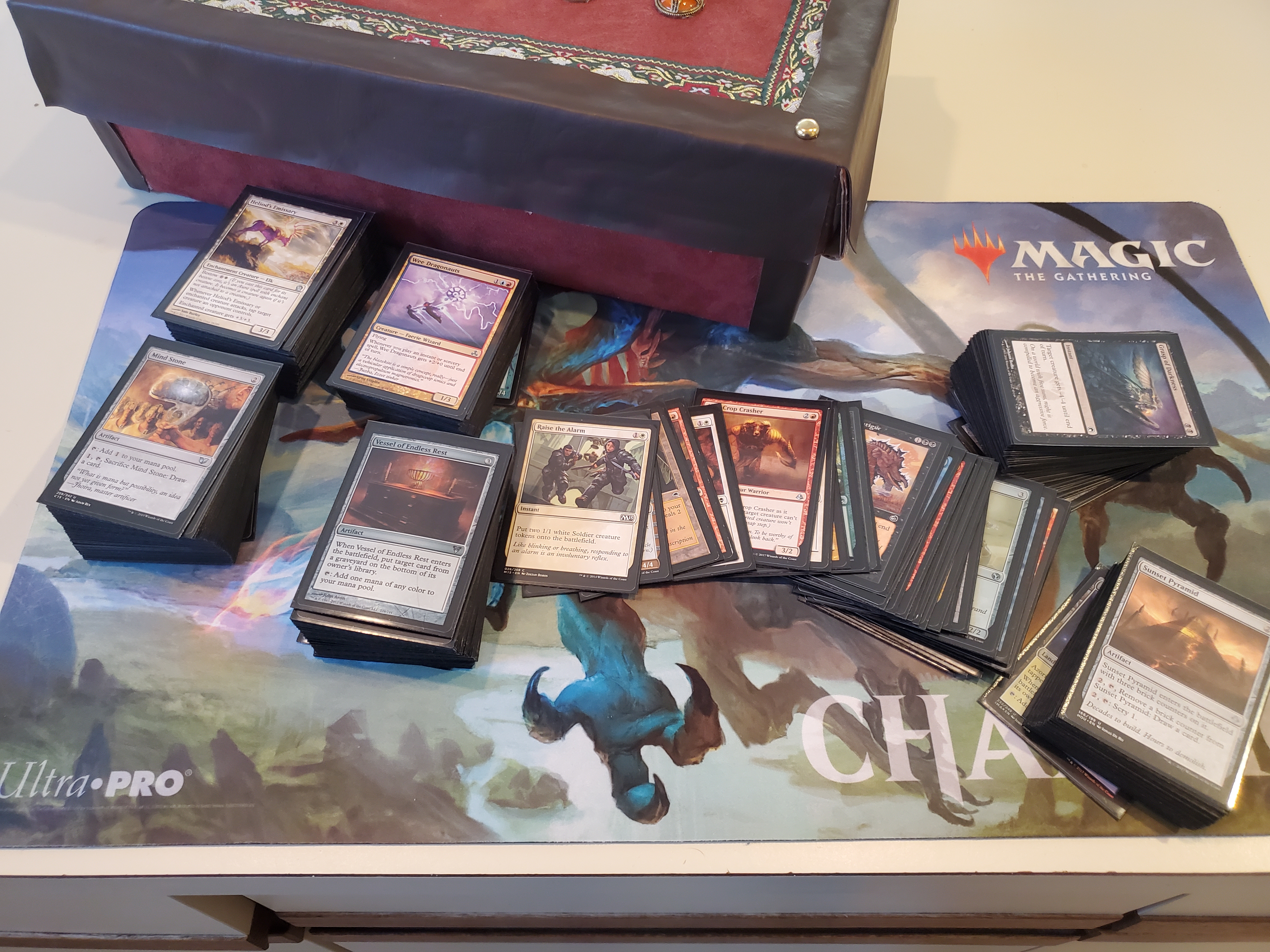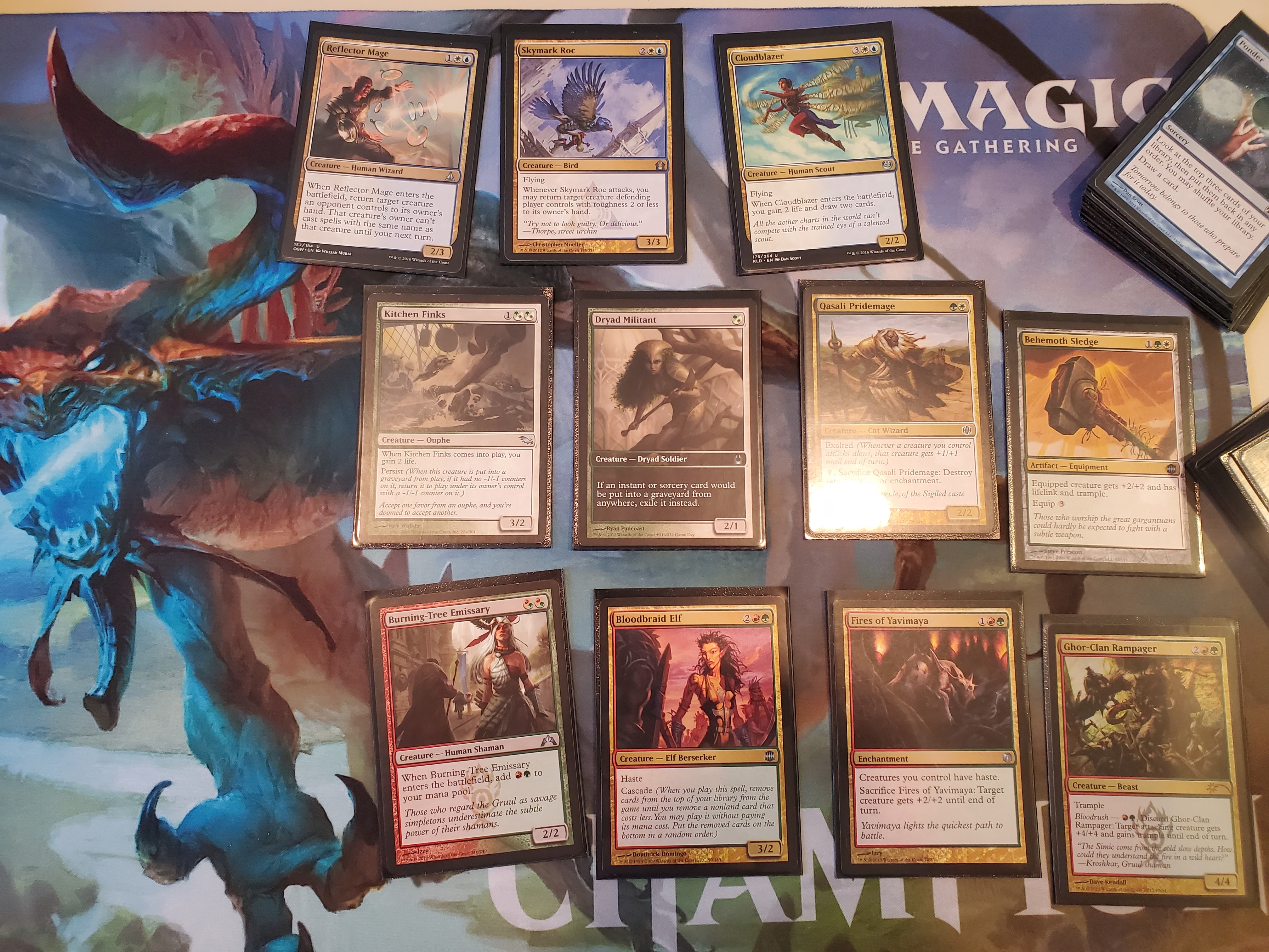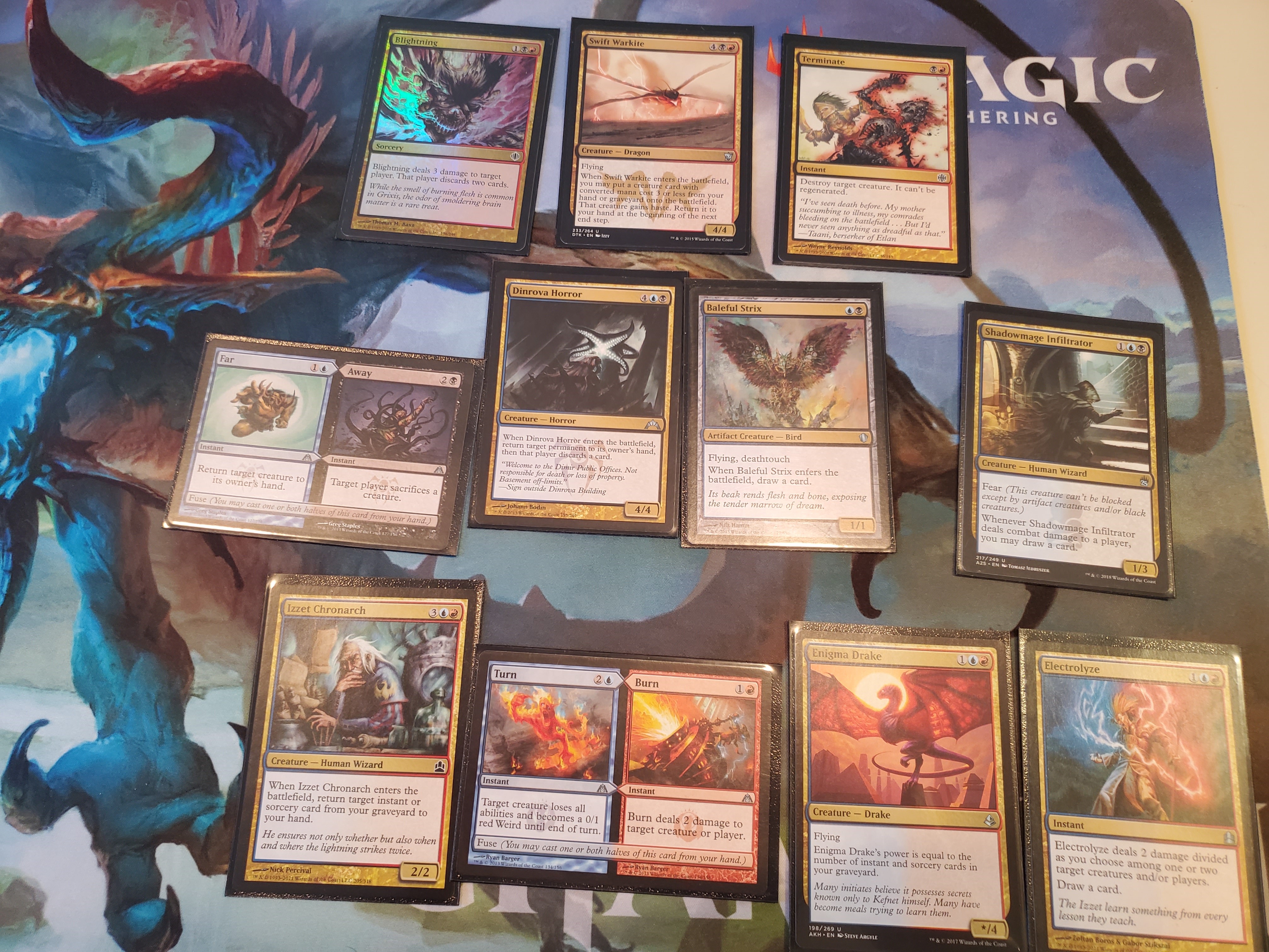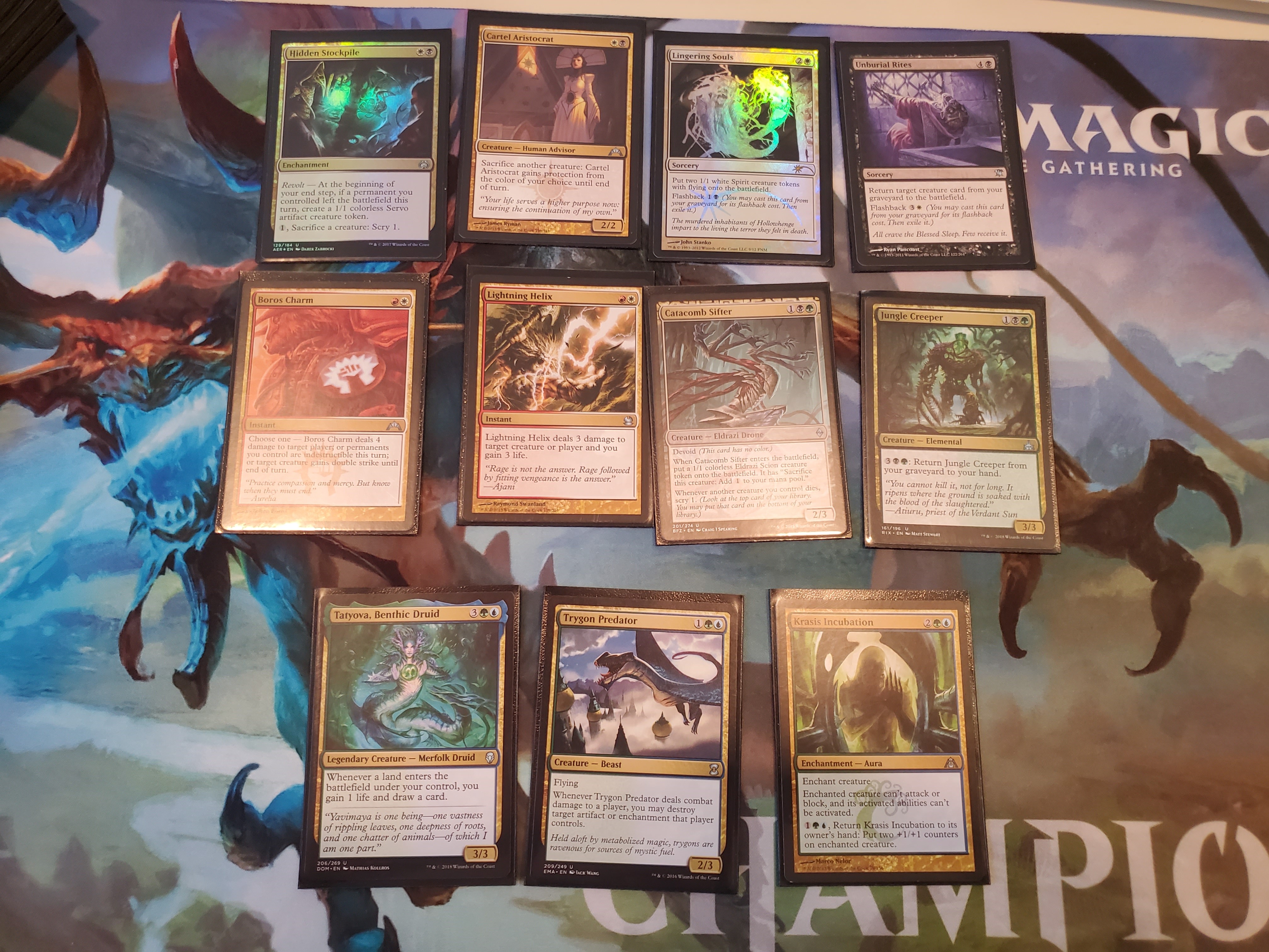Peasant Cube
Why did I make this?

I had the idea for a peasant cube in high school when I realized that a lot of cool draft cards were never played again after a new set came out. I wanted to be able to share some of the coolest cards in magic with my friends, especially as I was about to move to college in Rochester. This set was designed to be easy for new players due to it’s simple cards. It should show off some of magic’s most iconic cards while showing off some of the best synergies in magic focused around the Ravnica guild colors. Lastly, it should be replayable and fun for advanced players to explore interesting card combinations that they’ve never been confronted with before.
What is a Peasant Cube?
This peasant cube is a living singleton cube constructed entirely of commons and uncommon cards. A cube is a casual limited (players come prepared with no cards) set that is designed to be played with itself as a self contained game. The card rarity is based on the lowest rarity that the card was ever printed. For example, Clone was printed at both rare and uncommon, so it can be included.
Why draft peasant cube over other cubes?
Peasant cube is designed to feel more like a complex limited match. Unlike other cubes with rares, the power level of cards is limited. Some benefits of this include, less text on the card so new players can understand the cards faster, higher synergistic games since all cards are trying to synergize with each other rather than play the star, and less swingy high skill games since victories are won in inches over miles.
How can you play this cube?
In my experience there are 3 different variations of limited formats that this cube works with based on the number of people you have to play with.
For 2 players, you can play square draft. This format involves seperating out a set of 15 packs of 9 cards. For each ‘pack’ you flip the cards over in a 3x3 square and each player gets to take a line from the square. Players end up with a pool of 35-45 cards that they can construct a 40 card deck from.
For 2-4 players, players can do “4 pack sealed”. This is like regular sealed but due to the similar power level of cards, 4 packs are more than enough to construct a powerful strategy.
For 5+ players, a regular booster draft is fine.
What are the archetypes?
The archetypes are primarily based on two color combinations. Those who are familiar with the ravnica guilds will understand where these come from. There are no 3 color cards in the cube (outside of tri-lands). The most powerful payoff cards in the cube are the multicolor cards, they are intended to highlight the strategy.

U/W (Azurius)
This archetype is based on tempo and flying creatures. This can be shown through tempo based cards like Lyev Skyknight and Skymark Roc which both slow down your opponents creatures long enough to kill them before they have an opportunity to be relevant. Some key mono-colored cards include Mist Raven, Favorable Winds, and Aerial Responder.
G/W (Selesnya)
This is the tokens based strategy. A selesnya player can commonly be found casting Trostani’s Summoner and populating the rhino with Vitu-Ghazi Guildmage. Cards that also work well in this strategy are equipment that make your creatures big (and trade well).
R/G (Gruul)
This is the haste based aggro deck. Games are frequently won on the back of Bloodbraid Elf and Fires of Yavimaya. The bloodrush mechanic also helps in providing some of the few combat tricks in the cube as well as they are pseudo haste for your creatures.
U/B (Dimir)

This archetype is just control 2 for 1s. I mean, just look at Dinrova Horror.
B/R (Rakdos)
Unlike the normal rakdos strategy (attack at any costs), the rakdos strategy here is primarily based on board wipes, artifacts, and control. Some key cards are Rakdos Keyrune, Blightning, and Bituminous Blast.
U/R (Izzet)
Izzet is a ‘spells matter’ deck that runs a few win conditions and then wins off the back of cards like Young Pyromancer, Wee Dragonauts, or Enigma Drake.
W/B (Orzhov)

The orzhov play slow grindy games that will make your opponent not realize that they’ve lost the game about 10 turns ago. This includes winning card advantage wars off of the Hidden Stockpile and Unburial Rites.
B/G (Golgari)
Golgari is a midrange/combo deck that intends on putting Ulamogg’s Crusher or Pelakka Worm in the graveyard and reanimating it with Makeshift Manequin or Animate Dead.
G/U (Simic)
Simic is the ramp deck that wants to gather more resources than their opponent. For example Spring//Mind will ramp you into a River Hoopoe that cycles or Roaring Primadox that bounces a creature that has a good enter the battlefield ability.
R/W (Boros)
Boros is an aggressive, efficient, ‘go wide’ strategy. Small creatures can chip in for a few points of damage until the boros player plays a Flame-Kin Zealot or Goblin Trenches to finish off their opponent.
Colors

The individual colors are intended to support the guild’s strategies. Most cards will be able to be played in two or more archetypes.
Artifacts
Just because it can go in your deck, doesn’t mean that it’s designed to. Equipment are typically better on a token than a 8 mana 8/8.
Lands
The lands include the cycle of karoo (bounce) lands, a cycle of tri color lands, a cycle of spell (or creature) lands, a cycle of ‘cycle’ lands and miscellaneous fixing/manlands/utility lands.
Mono Color Decks
I think that realistically, only white, red, and black would be able to support this. Green and blue just do not have enough removal on their own.
Tri-Color Decks
Some guilds pair better with others. It’s definitely doable but the table can’t support everyone playing 3 colors. In addition, fixing is good enough that 5 color decks are viable but they’re difficult to put together and do not dominate by themselves once all 5 colors are assembled.
Feedback
Please give me any feedback that you have (good or bad!). This cube is my brain child and I don’t have a lot of opportunities to draft it, so each time I try to gather as much data as possible. What was fun? What was not? What did you like? What did you not like? What underperformed? What overperformed?
Ban List
The following cards were tried but deemed to be too powerful and led to games that were too warped by the cards. One interesting case is Loxodon Warhammer. It’s functionally the same card as Behemoth Sledge. But Loxodon Warmmaer is banned because of its colorless versatility in every deck. Multicolor cards are typically more powerful than their mono-colored counterparts due to the difficult casting cost balancing them out.
Control Magic at 4 mana would completely swing games since enchantment removal is fairly limited and stealing the best player’s creature is closer to a 4 for 1 than a 2 for 1. Bounce lands are too strong as there is little land destruction to counter them and they can be played in almost every deck that isn’t an aggro deck since they are a land that provides card advantage at 2 mana.
- Sol Ring
- Loxodon Warhammer
- Control Magic
- Skullclamp
- karoo (bounce) lands
